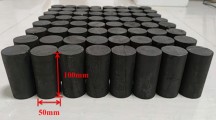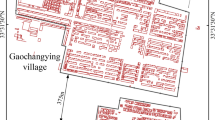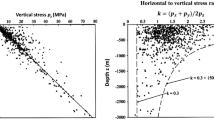Abstract
To analyse the impact of underground pressure on the variation in floor porosity and pore water pressure distribution during the coal seam mining process, this paper uses closed and open water pressure sensors to analyse rock pressure, water pressure zoning and layer distribution characteristics of the coal seam floor under mining effects based on a simulation analysis method using similar rock materials; the results determine that the separation characteristics of the pore water pressure distribution are affected by the rock pressure ‘barrier’ function, which is caused by changes in rock permeability under the coupling effect. To quantitatively analyse the rock pressure barrier’s impact on the floor mechanical structure, this paper proposes the ‘virtual separation layer’ concept and defines the virtual separation layer index to determine the scope of the floor tension fracture zone. Through monitored data of pore water pressure at different depths of the floor during field mining, the variation between the water pressure, porosity, mining distance and floor depth is obtained; similar material simulation results are verified, and a zonal distribution model of pore water pressure in the floor is established, providing a reference to investigate the distribution of pore water pressure in the floor under mining disturbances. The results show that the influence of changes in mining stress will also lead to a differential distribution of the floor mechanical properties and ultimately damage the floor and affect the inrush of the confined water. The research results play an important role in risk classification and prevention of water pressure distribution in coal seam floors.












Similar content being viewed by others
References
Cao QK, Zhao F (2012) Forecast of water inrush quantity from coal floor based on genetic algorithm support vector regression. J China Coal Soc 36(12):2097–2101
Chen J, Yin L, Sun W, Lu C, Zhang S, Sun X (2015) Development and application for new solid-fluid coupling similar material of deep floor Aquifuge. Chin J Rock Mech Eng 34(S2):3956–3964
Chen Y, Lian H, Liang W, Yang J, Nguyen VP, Bordas Stéphane PA (2019) The influence of fracture geometry variation on non-Darcy flow in fractures under confining stresses. Int J Rock Mech Min Sci 113:59–71
Chen S, Du Z, Zhang Z, Zhang H, Xia Z, Feng F (2020) Effects of chloride on the early mechanical properties and microstructure of gangue-cemented paste backfill. Constr Build Mater. https://doi.org/10.1016/j.conbuildmat.2019.117504
Duan M, Jiang C, Gan Q, Li M, Peng K, Zhang W (2019a) Experimental investigation on the permeability, acoustic emissionand energy dissipation of coal under tiered cyclic unloading. J Nat Gas Sci Eng. https://doi.org/10.1016/j.jngse.2019.103054
Duan M, Jiang C, Gan Q, Zhao H, Yang Y, Li Z (2019b) Study on permeability anisotropy of bedded coal under true triaxial stress and its application[J]. Transp Porous Media. https://doi.org/10.1007/s11242-019-01375-y
Feng F, Li X, Du K et al (2020) Comprehensive evaluation of strength criteria for granite, marble and sandstone based on polyaxial experimental tests. Int J Geomech. https://doi.org/10.1061/(ASCE)GM.1943-5622.0001544
Gong B, Jiang Y, Chen L (2019) Feasibility investigation of the mechanical behavior of methane hydrate-bearing specimens using the multiple failure method[J]. J Nat Gas Sci Eng 69:102915
Gong B, Jiang Y, Yan P (2020) Discrete element numerical simulation of mechanical properties of methane hydrate-bearing specimen considering deposit angles[J]. J Nat Gas Sci Eng 76:103182
Guo W, Zhao J, Yin L, Kong D (2017) Simulating research on pressure distribution of floor pore water based on fluid-solid coupling. Arab J Geosci 10(1):1–14
Hou P, Gao F, Ju Y, Cheng H, Gao Y, Xue Y, Yang Y (2016) Changes in pore structure and permeability of low permeability coal under pulse gas fracturing. J Nat Gas Sci Eng 34:1017–1026
Hu W, Zhu K, SOCIETY Xuanming Huang (2010) Study on floor rock mass failure and water inrush caused by non-uniform distributed water pressure in mining face. J China Coal Soc 35(7):1109–1114
Jiang C, Niu B, Yin G, Zhang D, Yu T, Wang P (2019a) CT-based 3D reconstruction of the geometry and propagation of hydraulic fracturing in shale [J]. J Pet Sci Eng 179:899–911
Jiang B, Gu S, Wang L, Zhang G, Li W (2019b) Strainburst process of marble in tunnel-excavation-induced stress path considering intermediate principal stress. J Cent South Univ 26(4):984–999
Jiang N, Wang C, Pan H, Yin D, Ma J (2020) Modeling study on the influence of the strip filling mining sequence on mining-induced failure. Energy Sci Eng 00:1–17. https://doi.org/10.1002/ese3.660
Li B (1999) “Down Three Zones” in the Prediction of the water inrush from Coalbed Floor Aquifer-theory , Development and Application. J Shandong Inst Min Technol (Nat Sci) 18(4):11–18
Li B, Wu Q (2019) Catastrophic evolution of water inrush from a water-rich fault in front of roadway development: a case study of the Hongcai coal mine. Mine Water Environ 3:1–10
Li L, Lu W, Li S, Zhang Q, Sun B, Shi S (2010) Research status and developing trend analysis of the water inrush mechanism for underground engineering construction. J Shandong Univ (Eng Sci) 40(3):104–118
Liu Q, Chai J, Chen S, Zhang D, Yuan Q, Wang S (2020) Monitoring and correction of the stress in an anchor bolt based on pulse PrePumped Brillouin optical time domain analysis. Energy Sci Eng. 00:1–13. https://doi.org/10.1002/ese3.644
Liu Q, Liu X (2014) Research on critical problem for fracture network propagation and evolution with multifield coupling of fractured rock mass. Rock Soil Mech 35(2):305–320
Lu Y, Wang L (2015a) Numerical simulation of mining-induced fracture evolution and water flow in coal seam floor above a confined aquifer. Comput Geotech 67:157–171
Lu Y, Wang L (2015b) Numerical modeling of mining-induced fracturing and flow evolution in coal seam floor based on micro-crack growth. Chin J Rock Mech Eng 32(6):890–897
Mandal A, Basantaray Aurobindo K, Chandroth A, Mishra U (2019) Integrated geophysical investigation to map shallow surface alteration/fracture zones of Atri and Tarabalo hot springs, Odisha, India. Geothermics 77:24–33
Shi L (2009) Summary of research on mechanism of water-inrush from seam floor. J Shandong Univ Sci Technol 28(3):17–23
Shi L, Mei Q, Wei W (2014) Water inrush evaluation of coal seam floor by integrating the water inrush coefficient and the information of water abundance. Int J Min Sci Technol 24:677–681
Sun W, Zhang S, Li Y, Lu C (2015) Development application of solid-fluid coupling similar material for floor strata and simulation test of water inrush in deep mining. Chin J Rock Mech Eng 34(s1):2665–2670
Sun W, Zhou F, Liu J, Shao J (2020) Experimental study on Portland cement/calcium sulfoaluminate binder of paste filling. Eur J Environ Civ Eng. https://doi.org/10.1080/19648189.2020.1731712
Wang C, Shen B, Juntao C, Tong W, Jiang Z, Liu Y, Li Y (2020) Compression characteristics of filling gangue and simulation of mining with gangue backfilling: an experimental investigation. Geomech Eng 20(6):485–495
Wang Z, Hongquan L (1992) Mining above high water pressure aquifer. China Coal Industry Publishing House, M, Beijing
Wang Z, Hongquan L (1994) Analysis and calculation of ultimate water resistance capacity of remaining intact rock mass in floor space. Chin J Rock Mech Eng 13(4):320–326
Wei J, Li B (2000) Security Evaluation Of Coal Mining Above The Confined Aquifers. Coal Geol Ex Plo Ration 28(4):57–59
Wu J, Fan C (2003) Study on in-situ measurement of water-resisting ability of coal seam floor rock mass. Chin J Geotech Eng 25(1):67–70
Wu Q, Liu Y, Wu X, Liu S, Sun W, Zeng Y (2016) Assessment of groundwater inrush from underlying aquifers in Tunbai coal mine, Shanxi province, China. Environ Earth Sci 75(9):737
Wu C, Chu J, Wu S, Hong Y (2019) 3D characterization of microbially induced carbonate precipitation in rock fracture and the resulted permeability reduction. Eng Geol 249:23–30
Wu Q, Xie S, Zhenjiang P, Ma J (2007) A new practical methodology of the coal floor water bursting evaluating? : The application of ANN vulnerable index method based on GIS. J China Coal Soc 32(12):1301–1306
Xiao G, Chen C (2018) Simulation of progressive failure process and stability analysis method for rock block. Rock Soil Mech 39(8):292–301
Xue Y, Sun W, Wu Q (2020) The influence of magmatic rock thickness on fracture and instability law of mining surrounding rock. Geomech Eng 20(6):000–000. https://doi.org/10.12989/gae.2020.20.6.000
Xu ZH, Huang X, Li SC, Lin P, Shi XS, Wu J (2019) A new slice-based method for calculating the minimum safe thickness for a filled-type karst cave. Bull Eng Geol Environ:1–15. https://doi.org/10.1007/s10064-019-01609-9
Yan D, Xi Y, Lingling P (2010) Coal floor water bursting risk evaluation system based on water bursting coefficient——a case study in Gujiao mine area, Xishan coalfield, Taiyuan, Shanxi. Coal Geol China 22(4):31–34
Yin S, Zhang J, Demin L (2015) A study of mine water inrushes by measurements of in situ stress and rock failures. Nat Hazards 79:1961–1979
Zhang HQ, He YN, Tang CA, Bashir A, Han LJ (2009) Application of an improved flow-stress-damage model to the criticality assessment of water inrush in a mine: a case study. Rock Mech Rock Eng 42(6):911
Zhang R, Ning Z, Yang F, Wang X, Zhao H, Wang Q (2015) Impacts of nanopore structure and elastic properties on stress-dependent permeability of gas shales. J Nat Gas Sci Eng 26:1663–1672
Zhang W, Yuan J, Wang Z, Zhu J (2017) An experimental study on compressive shear seepage laws of mining-induced fractured rock mass. Rock Soil Mech 38(9):2473–2479
Zhao J, Jiang N, Yin L, Bai L (2019) The effects of mining subsidence and drainage improvements on a waterlogged area. Bull Eng Geol Environ 78(5):3815–3831. https://doi.org/10.1007/s10064-018-1356-9
Zhao J, Yin L, Guo W (2018) Stress–seepage coupling of Cataclastic rock masses based on digital image technologies. Rock Mech Rock Eng 51(8):2355–2372
Zhao J, Zhang X, Jiang N et al (2020a) Porosity zoning characteristics of fault floor under fluid-solid coupling. Bull Eng Geol Environ. https://doi.org/10.1007/s10064-019-01701-0
Zhao J, Li B,Chen J, Jiang N (2020b) Mechanism of seepage-stress fault water inrush and grouting seal. Arab J Geosci. https://doi.org/10.1007/s12517-020-05319-5
Zhou F, Sun WB, Shao JL, Kong LJ, Geng XY (2020) Experimental study on nano silica modified cement base grouting reinforcement materials. Geomech Eng 20(1):67–73. https://doi.org/10.12989/gae.2020.20.1.067
Zhu B, Wu Q, Yang J (2014) Study of pore pressure change during mining and its application on water inrush prevention: a numerical simulation case in Zhaogezhuang coal mine. Environ Earth Sci 71:2115–2132
Acknowledgements
Funding was provided by National Key R&D Program of China (2018YFC0604705); SDUST Research Fund (grant 2018TDJH102); National Natural Science Foundation of China (Grant Nos. 51574159 51974172, 51974173, 51804179) and the SDUST Research Fund, Shandong Province Natural Science Foundation Project (ZR2017MEE055; 2018GSF116002; 2019GSF111024); China postdoctoral science foundation (2015M572067, 2016T90662).
Funding
Funding was provided by National Natural Science Foundation of China (grant nos. 51974172, 51974173 and 51804179), SDUST Research Fund, Shandong Province Natural Science Foundation Project (ZR2017MEE055, 2018GSF116002).
Author information
Authors and Affiliations
Corresponding authors
Rights and permissions
About this article
Cite this article
Zhao, J., Chen, J., Zhang, X. et al. Distribution characteristics of floor pore water pressure based on similarity simulation experiments. Bull Eng Geol Environ 79, 4805–4816 (2020). https://doi.org/10.1007/s10064-020-01835-6
Received:
Accepted:
Published:
Issue Date:
DOI: https://doi.org/10.1007/s10064-020-01835-6




